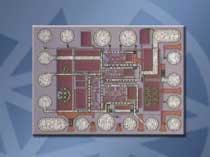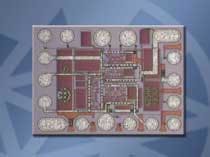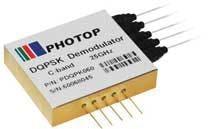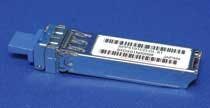The high–performance DQPSK demodulator is the newest addition to the company's 40–Gbit component family. This 40Ã�35Ã�8.5–mm device is based on the company's patented Free Space Micro Optics Block (FSMOB) technology. It features insertion loss of 5 dB; free spectral range of 21.5, 25, and 32.5 GHz; isolation of >16 dB; PMD of 0.1 psec; and return loss of 40 dB. Operating temperature is –5~+65°C, and storage temperature is –40~+80°C.
Photop Technologies, www.photoptech.com
A new generation of high–power collimated laser modules targets customers in need of high–brightness laser sources with low beam divergence. Featuring fast axis collimation and a compact package design, the collimated laser modules come in two types: fixed collimation optics, preset to meet customers' application requirements in terms of beam divergence or spot size; and adjustable collimation optics, enabling the end user to fine–tune the laser output for the optimal beam shape required by the application. The modules are built around the 9–mm TO–can package.
Modulight, www.modulight.com
The CWDM–SFP+ transceiver module can provide parallel transmission at 80 Gbits/sec. This 10–Gbit/sec CWDM SFP+ module is MSA–compatible and allows up to 48 ports per line card. The internal DFB LD chip achieves lower reduced parasitic capacitance than the existing one, according to company claims. The module covers a center wavelength from 1470 to 1610 nm with 20–nm spacing. Since transmission distance is less than 10 km, power penalty due to chromatic dispersion can be negligible. The device will be launched in 2009.
Sumitomo Electric Industries Ltd., www.sei.co.jp/index.en.html
Multiplexer/demultiplexers
Coarse wavelength division multiplexer (CWDM) and optical add/drop multiplexer (OADM) products are now part of the company's MEF–certified iConverter product family. These new modules install in any iConverter chassis alongside other iConverter products, occupy a minimal amount of rack space, and provide some of the highest port densities in the industry, claims the company. The modules are available in expandable four–channel and eight–channel configurations, with a full complement of added features and functions. They can be installed in new or existing networks with other iConverter system components. Up to 19 four–channel modules (76 ports) can be installed in a 2U–high equipment rack. Alternatively, up to nine eight–channel modules (72 ports) can occupy the same area. The units are completely passive and require no external power. Optional features include a tap/maintenance port that facilitates troubleshooting and monitoring, and 1310–nm channel pass–through technology, which allows a wide range of CWDM wavelengths to be added to existing 1310–nm SONET/SDH rings without affecting existing services.
Omnitron Systems Technology, www.omnitron–systems.com
EP30 epoxy adhesive for high–performance bonding applications features very low viscosity along with chemical resistance, dimensional stability, hardness, and good optical clarity, claims the company. EP30 is widely used in potting and encapsulating electronic components as well as in bonding optical elements. For medical applications, a USP Class VI approved version called EP30MED is also available. The adhesive adheres to a variety of substrates, including metals, ceramics, glass, and many plastics. Typically, the lap shear strength exceeds 3,000 psi for aluminum–to–aluminum bonds. EP30 also has low shrinkage upon cure. It is suitable for assemblies where only very thin bond lines are dictated by design considerations. The adhesive is available in 1/2 pint, pint, quart, gallon, and five–gallon kits, as well as in gun applicators and double–pouch divider packs.
Master Bond Inc., www.masterbond.com
Amplification equipment
The UltraSpan family of amplification equipment addresses the challenges of ultra–long repeaterless links and long spans within multi–span links. The UltraSpan products can be used individually or in any combination to extend the span reach of existing system designs. It supports ultra–long point–to–point repeaterless links of up to 70 dB using standard transponders (corresponding to about 350 km) as well as long spans that are part of a multi–span network. The UltraSpan suite is used for enterprise SANs, disaster recovery, and security sensitive networks. Four complementary products are included in the suite: the UltraSpan Raman, which provides up to 1.2 W of co– or counter–propagating Raman pump power; the UltraSpan Power Booster, which provides up to 26 dBm of launch power; the UltraSpan ROPA, which provides up to 1.2 W of combined counter–propagating Raman pump power and 1480–nm pump power for remote EDF pumping; and the UltraSpan Submarine Terminal, a modular EDFA/Raman/ROPA unit designed for stringent low FIT (very high reliability) network applications.
RED–C Optical Networks Ltd., www.red–c.com




